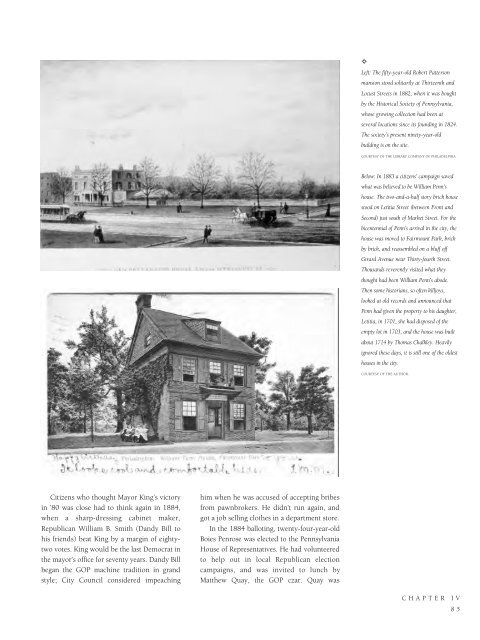Historic Philadelphia
An illustrated history of the city of Philadelphia, paired with the histories of companies, families and organizations that make the region great.
An illustrated history of the city of Philadelphia, paired with the histories of companies, families and organizations that make the region great.
You also want an ePaper? Increase the reach of your titles
YUMPU automatically turns print PDFs into web optimized ePapers that Google loves.
✧<br />
Left: The fifty-year-old Robert Patterson<br />
mansion stood solitarily at Thirteenth and<br />
Locust Streets in 1882, when it was bought<br />
by the <strong>Historic</strong>al Society of Pennsylvania,<br />
whose growing collection had been at<br />
several locations since its founding in 1824.<br />
The society’s present ninety-year-old<br />
building is on the site.<br />
COURTESY OF THE LIBRARY COMPANY OF PHILADELPHIA.<br />
Below: In 1883 a citizens’ campaign saved<br />
what was believed to be William Penn’s<br />
house. The two-and-a-half story brick house<br />
stood on Letitia Street (between Front and<br />
Second) just south of Market Street. For the<br />
bicentennial of Penn’s arrival in the city, the<br />
house was moved to Fairmount Park, brick<br />
by brick, and reassembled on a bluff off<br />
Girard Avenue near Thirty-fourth Street.<br />
Thousands reverently visited what they<br />
thought had been William Penn’s abode.<br />
Then some historians, so often killjoys,<br />
looked at old records and announced that<br />
Penn had given the property to his daughter,<br />
Letitia, in 1701, she had disposed of the<br />
empty lot in 1703, and the house was built<br />
about 1714 by Thomas Chalkley. Heavily<br />
ignored these days, it is still one of the oldest<br />
houses in the city.<br />
COURTESY OF THE AUTHOR.<br />
Citizens who thought Mayor King’s victory<br />
in ’80 was close had to think again in 1884,<br />
when a sharp-dressing cabinet maker,<br />
Republican William B. Smith (Dandy Bill to<br />
his friends) beat King by a margin of eightytwo<br />
votes. King would be the last Democrat in<br />
the mayor’s office for seventy years. Dandy Bill<br />
began the GOP machine tradition in grand<br />
style; City Council considered impeaching<br />
him when he was accused of accepting bribes<br />
from pawnbrokers. He didn’t run again, and<br />
got a job selling clothes in a department store.<br />
In the 1884 balloting, twenty-four-year-old<br />
Boies Penrose was elected to the Pennsylvania<br />
House of Representatives. He had volunteered<br />
to help out in local Republican election<br />
campaigns, and was invited to lunch by<br />
Matthew Quay, the GOP czar. Quay was<br />
CHAPTER IV<br />
85
















